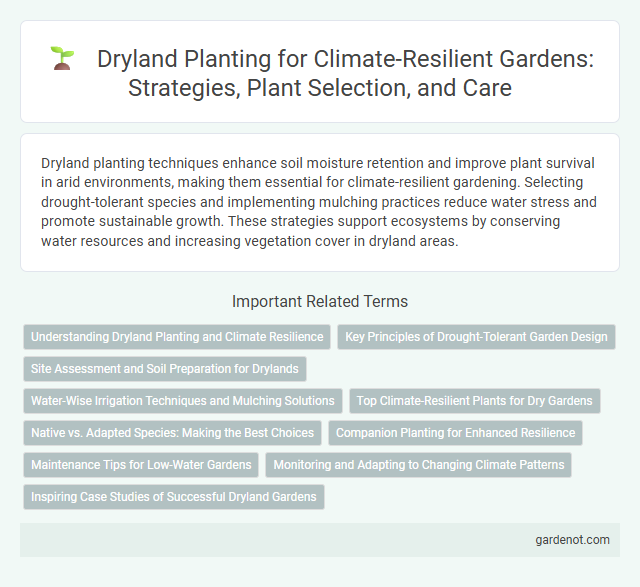Dryland planting techniques enhance soil moisture retention and improve plant survival in arid environments, making them essential for climate-resilient gardening. Selecting drought-tolerant species and implementing mulching practices reduce water stress and promote sustainable growth. These strategies support ecosystems by conserving water resources and increasing vegetation cover in dryland areas.
Understanding Dryland Planting and Climate Resilience
Dryland planting techniques optimize water use efficiency by selecting drought-tolerant crops and implementing minimal-tillage practices that preserve soil moisture and reduce erosion. Understanding soil composition, local climate patterns, and native vegetation is essential to enhance climate resilience and maintain productivity under variable rainfall conditions. Incorporating agroforestry and mulching further stabilizes microclimates, improves soil health, and supports sustained agricultural yield in arid and semi-arid regions.
Key Principles of Drought-Tolerant Garden Design
Drought-tolerant garden design emphasizes selecting native, deep-rooted plants that efficiently access limited water resources in dryland environments. Soil enhancement techniques, such as incorporating organic mulch and improving soil structure, retain moisture and reduce evaporation. Strategic plant placement maximizes shade and wind protection, further conserving water and promoting climate resilience.
Site Assessment and Soil Preparation for Drylands
Site assessment for dryland planting involves evaluating soil texture, water retention capacity, and topography to ensure optimal seed selection and planting depth. Soil preparation focuses on enhancing soil structure through minimal tillage, organic matter incorporation, and erosion control techniques to maximize moisture conservation. Proper assessment and preparation increase plant survival rates and promote sustainable growth in arid environments.
Water-Wise Irrigation Techniques and Mulching Solutions
Water-wise irrigation techniques in dryland planting optimize moisture retention by utilizing drip irrigation systems that deliver water directly to plant roots, minimizing evaporation and runoff. Mulching solutions, such as organic compost or straw, create a protective layer over the soil, conserving moisture, reducing weed growth, and improving soil temperature regulation. Implementing these strategies significantly enhances the resilience of crops in arid environments, promoting sustainable water use and improving overall plant health.
Top Climate-Resilient Plants for Dry Gardens
Top climate-resilient plants for dry gardens include drought-tolerant species such as lavender, agave, and yucca, which thrive with minimal water while maintaining vibrant foliage. These plants possess deep root systems that enhance soil stability and improve moisture retention, making them ideal for arid environments. Incorporating native xerophytic species further boosts resilience by adapting naturally to local climate stressors and reducing maintenance needs.
Native vs. Adapted Species: Making the Best Choices
Dryland planting requires selecting species that can thrive in arid conditions with minimal water. Native species are often best suited for dryland environments due to their evolved resilience to local climate and soil conditions, enhancing long-term sustainability and biodiversity. Adapted species, while not originally native, can provide additional drought tolerance and soil stabilization but require careful evaluation to avoid invasive risks and ensure ecological balance.
Companion Planting for Enhanced Resilience
Companion planting in dryland areas enhances climate resilience by improving soil moisture retention and reducing pest infestations naturally. Strategic selection of drought-tolerant species such as pigeon pea alongside sorghum increases resource efficiency and yield stability. Integrating nitrogen-fixing legumes with deep-rooted crops optimizes nutrient cycling and supports long-term ecosystem health under arid conditions.
Maintenance Tips for Low-Water Gardens
Dryland planting thrives with strategic maintenance that maximizes water efficiency and plant health. Mulching with organic materials reduces soil evaporation, while deep, infrequent watering encourages resilient root systems. Choosing native drought-tolerant species further supports sustainable growth in low-water gardens.
Monitoring and Adapting to Changing Climate Patterns
Effective dryland planting requires continuous monitoring of rainfall variability, soil moisture levels, and temperature fluctuations to anticipate climate impacts. Utilizing remote sensing technologies and climate models enables timely adaptation of crop selection and planting schedules. Implementing adaptive management practices enhances drought resilience and sustains agricultural productivity in arid environments.
Inspiring Case Studies of Successful Dryland Gardens
Dryland planting techniques demonstrated in the Loess Plateau in China have successfully transformed arid landscapes into thriving gardens by employing water conservation methods such as contour trenching and mulching. The African Sahel region showcases community-led dryland gardens that combine drought-tolerant species like moringa and millet, significantly improving food security and soil health. Indigenous practices in Australia's arid zones utilize native plants like acacias and spinifex grasses to create resilient ecosystems that withstand prolonged drought conditions.
Dryland planting Infographic

 gardenot.com
gardenot.com